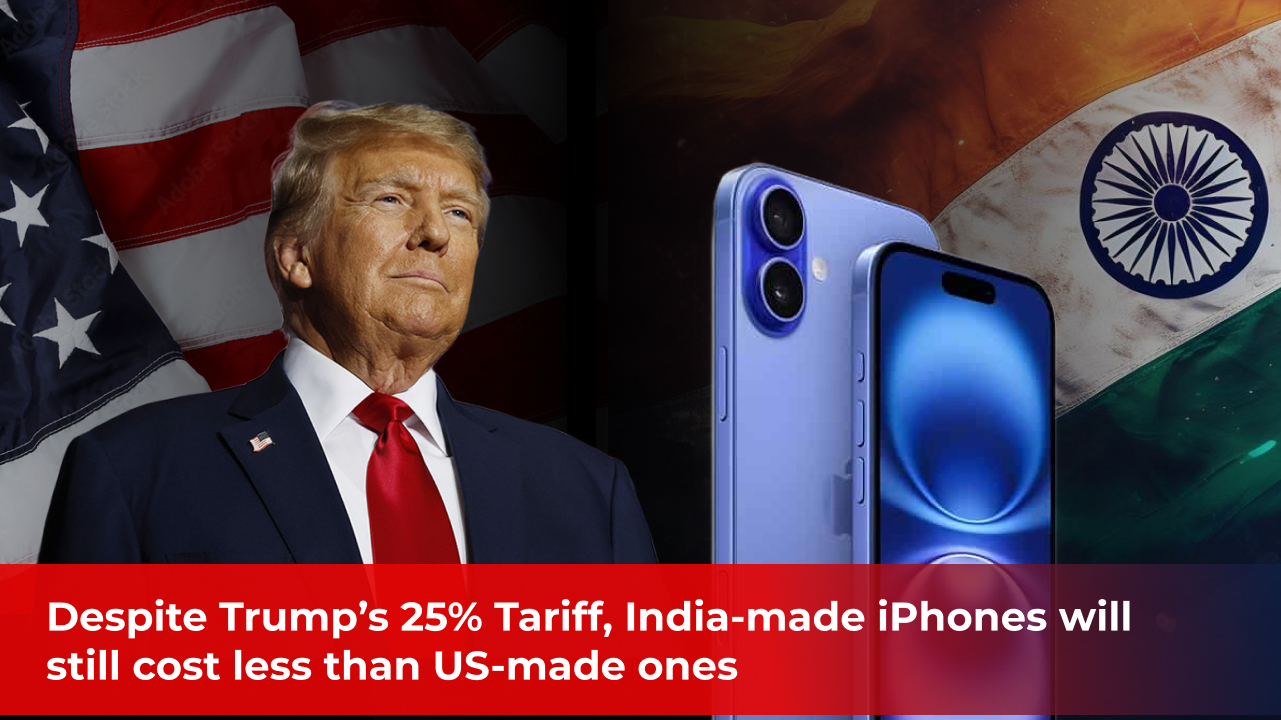The Global Trade Research Initiative (GTRI) report says that even after adjusting the 25% tariff on iPhones, the manufacturing of iPhones in India would be less than in the US. The president of the United States, Mr Donald Trump, threatened to impose a 25% tariff in his statement. The statement clearly shows that President Trump is not happy with Apple's decision to make iPhones in India. The news came to light when he was speaking in the White House Oval Office; he referenced the statement about the discussion with Apple CEO Tim Cook.

Geopolitical tensions are rising day by day, and this time, Apple has decided to reshape its global manufacturing strategy so that they are not showing any signs of backing down even after the warning from US President Trump. Here, India's government programs also encourage Apple to shift its supply chain ecosystem in India, and since the investments related to it had been seen before, the picture is clear. India is not just a competitor to China in terms of effective manufacturing costs, but it will also become Apple's new production base.
"I had an understanding with Tim that he wouldn't be doing this. He said he's going to India to build plants. I said, 'That's okay, but you're not going to sell into here without tariffs." Mr. Trump was stressed the quote, "We're talking about the iPhone. If they're going to sell it in America, I want it to be built in the United States." later, he broadened his tariff threat and gave to all smartphone manufacturers, such as Samsung and Huawei, said, "It would be anybody that makes that product. Otherwise it wouldn't be fair."
Apple earns a major chunk of its revenue from its iPhones due to its software and design, but its brand name plays a vital role in its sales. Many of its customers purchase iPhones because of Apple's brand name. When considering iPhone production, around $80 of the cost of the iPhone is for the parts given by US companies like Qualcomm and Broadcom, around $90 worth of memory chips and displays contributed by South Korea, Japan contributes the camera components that are worth around $85, its assembly and testing plays the crucial role, and China and India costs $30 for that which is lesser than 3 percent of the selling price.
| Country / Region | Contribution (USD) | What they provide |
| Apple (U.S.) | $450 | Brand, design, software |
| Taiwan | $150 | Chips |
| South Korea | $90 | OLED screens, memory chips |
| Japan | $85 | Camera modules |
| U.S. (Qualcomm etc.) | $80 | Semiconductor components |
| Germany, Vietnam, Malaysia | $45 | Smaller parts |
| China + India | $30 | Assembly |
*Data is sourced from a Global Trade Research Initiative (GTRI) report.
As per the reports, the tariff are likely to be imposed by the end of June 2025; on the same day, Trump wrote, "I expect their iPhones that will be sold in the United States of America will be manufactured and built in the United States, not India, or anyplace else. If that is not the case, a Tariff of at least 25 per cent must be paid by Apple to the US. American jobs come first!" He also states during his visit in Doha where he told Tim Cook to focus on manufacturing iPhones in their noting India's high tariff and policies and complex market access, "They've offered us a deal where they're willing to charge us no tariff, but I told Tim, 'I don't want you building in India. Build here.'" Trump insisted on prioritizing domestic production.
Why did Apple choose India for iPhone manufacturing even after the 25% tariff?
Thus, it is arguable that the manufacturing of iPhones in India is economically good for Apple even if the United States imposes 25% tariffs. A short comparison of costs can easily explain the situation. The labor cost in India for assembling iPhones is somewhere around USD 230 per month that a worker earns, but in the United States, for the same work, the labor cost would cost around USD 2,900 per month, which is over 12 times the cost. Here, it is important to highlight that in the US, there are minimum wage laws that cause drastic differences in the cost.
Apple addresses tariffs in its 2025 Q2 results, which describe how the product's manufacturing location affects the earnings. Industry experts also share their caution regarding the relocation of iPhone manufacturing to the United States, which would not be profitable; in fact, it would increase their costs. They share the reason behind how it would sharply increase costs due to higher labor and operational expenses, eventually making their iPhone prices go up to $3,000 or more.
If Apple shifts the production of iPhones in India, its manufacturing would cost them about $30 and it would be around $390 and it also heavly impact the profit earnings falls from $450 to $60 if it shifts to the United States.
